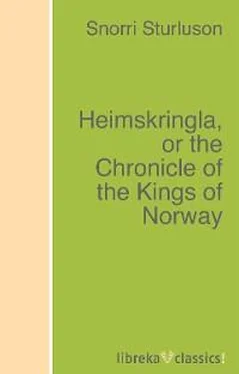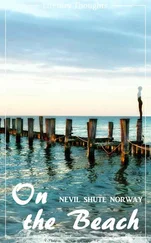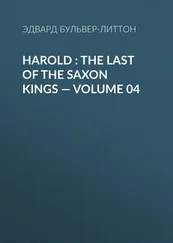Snorri Sturluson - Heimskringla, or the Chronicle of the Kings of Norway
Здесь есть возможность читать онлайн «Snorri Sturluson - Heimskringla, or the Chronicle of the Kings of Norway» — ознакомительный отрывок электронной книги совершенно бесплатно, а после прочтения отрывка купить полную версию. В некоторых случаях можно слушать аудио, скачать через торрент в формате fb2 и присутствует краткое содержание. Жанр: unrecognised, на английском языке. Описание произведения, (предисловие) а так же отзывы посетителей доступны на портале библиотеки ЛибКат.
- Название:Heimskringla, or the Chronicle of the Kings of Norway
- Автор:
- Жанр:
- Год:неизвестен
- ISBN:нет данных
- Рейтинг книги:3 / 5. Голосов: 1
-
Избранное:Добавить в избранное
- Отзывы:
-
Ваша оценка:
- 60
- 1
- 2
- 3
- 4
- 5
Heimskringla, or the Chronicle of the Kings of Norway: краткое содержание, описание и аннотация
Предлагаем к чтению аннотацию, описание, краткое содержание или предисловие (зависит от того, что написал сам автор книги «Heimskringla, or the Chronicle of the Kings of Norway»). Если вы не нашли необходимую информацию о книге — напишите в комментариях, мы постараемся отыскать её.
libreka classics – These are classics of literary history, reissued and made available to a wide audience.
Immerse yourself in well-known and popular titles!
Heimskringla, or the Chronicle of the Kings of Norway — читать онлайн ознакомительный отрывок
Ниже представлен текст книги, разбитый по страницам. Система сохранения места последней прочитанной страницы, позволяет с удобством читать онлайн бесплатно книгу «Heimskringla, or the Chronicle of the Kings of Norway», без необходимости каждый раз заново искать на чём Вы остановились. Поставьте закладку, и сможете в любой момент перейти на страницу, на которой закончили чтение.
Интервал:
Закладка:
This happened fifteen years after the death of Hakon, Athelstan's foster-son, and thirteen years after that of Sigurd earl of Hlader. The priest Are Frode says that Earl Hakon was thirteen years earl over his father's dominions in Throndhjem district before the fall of Harald Grafeld; but, for the last six years of Harald Grafeld's life, Are Frode says the Earl Hakon and Gunhild's sons fought against each other, and drove each other out of the land by turns.
14. GOLD HARALD'S DEATH.
Soon after Harald Grafeld's fall, Earl Hakon came up to Gold Harald, and the earl immediately gave battle to Harald. Hakon gained the victory, and Harald was made prisoner; but Hakon had him immediately hanged on a gallows. Hakon then went to the Danish king, and no doubt easily settled with him for the killing his relative Gold Harald.
15. DIVISION OF THE COUNTRY.
Soon after King Harald Gormson ordered a levy of men over all his kingdom, and sailed with 600 ships (1). There were with him Earl Hakon, Harald Grenske, a son of King Gudrod, and many other great men who had fled from their udal estates in Norway on account of Gunhild's sons. The Danish king sailed with his fleet from the south to Viken, where all the people of the country surrendered to him. When he came to Tunsberg swarms of people joined him; and King Harald gave to Earl Hakon the command of all the men who came to him in Norway, and gave him the government over Rogaland, Hordaland, Sogn, Fjord-district, South More, Raumsdal, and North More. These seven districts gave King Harald to Earl Hakon to rule over, with the same rights as Harald Harfager gave with them to his sons; only with the difference, that Hakon should there, as well as in Throndhjem, have the king's land-estates and land-tax, and use the king's money and goods according to his necessities whenever there was war in the country. King Harald also gave Harald Grenske Vingulmark, Vestfold, and Agder all the way to Lidandisnes (the Naze), together with the title of king; and let him have these dominions with the same rights as his family in former times had held them, and as Harald Harfager had given with them to his sons. Harald Grenske was then eighteen years old, and he became afterwards a celebrated man. Harald king of Denmark returned home thereafter with all his army.
16. GUNHILD'S SONS LEAVE THE COUNTRY.
Earl Hakon proceeded northwards along the coast with his force; and when Gunhild and her sons got the tidings they proceeded to gather troops, but were ill off for men. Then they took the same resolution as before, to sail out to sea with such men as would follow them away to the westward (A.D. 969). They came first to the Orkney Islands, and remained there a while. There were in Orkney then the Earls Hlodver. Arnfid, Ljot, and Skule, the sons of Thorfin Hausakljufer.
Earl Hakon now brought all the country under him, and remained all winter (A.D. 970) in Throndhjem. Einar Skalaglam speaks of his conquests in "Vellekla":—
As Hakon the earl proceeded this summer along the coast subjecting all the people to him, he ordered that over all his dominions the temples and sacrifices should be restored, and continued as of old. So it is said in the "Vellekla":—
The first winter that Hakon ruled over Norway the herrings set in everywhere through the fjords to the land, and the seasons ripened to a good crop all that had been sown. The people, therefore, laid in seed for the next year, and got their lands sowed, and had hope of good times.
17. HAKON'S BATTLE WITH RAGNFRED.
King Ragnfred and King Gudrod, both sons of Gunhild and Eirik, were now the only sons of Gunhild remaining in life. So says Glum Geirason in Grafeld's lay:—
Ragnfred began his course in the spring after he had been a year in the Orkney Islands. He sailed from thence to Norway, and had with him fine troops, and large ships. When he came to Norway he learnt that Earl Hakon was in Throndhjem; therefore he steered northwards around Stad, and plundered in South More. Some people submitted to him; for it often happens, when parties of armed men scour over a country, that those who are nearest the danger seek help where they think it may be expected. As soon as Earl Hakon heard the news of disturbance in More, he fitted out ships, sent the war-token through the land, made ready in all haste, and proceeded out of the fjord. He had no difficulty in assembling men. Ragnfred and Earl Hakon met at the north corner of More; and Hakon, who had most men, but fewer ships, began the battle. The combat was severe, but heaviest on Hakon's side; and as the custom then was, they fought bow to bow, and there was a current in the sound which drove all the ships in upon the land. The earl ordered to row with the oars to the land where landing seemed easiest. When the ships were all grounded, the earl with all his men left them, and drew them up so far that the enemy might not launch them down again, and then drew up his men on a grass-field, and challenged Ragnfred to land. Ragnfred and his men laid their vessels in along the land, and they shot at each other a long time; but upon the land Ragnfred would not venture: and so they separated. Ragnfred sailed with his fleet southwards around Stad; for he was much afraid the whole forces of the country would swarm around Hakon. Hakon, on his part, was not inclined to try again a battle, for he thought the difference between their ships in size was too great; so in harvest he went north to Throndhjem, and staid there all winter (A.D. 971). King Ragnfred consequently had all the country south of Stad at his mercy; namely, Fjord district, Hordaland, Sogn, Rogaland; and he had many people about him all winter. When spring approached he ordered out the people and collected a large force. By going about the districts he got many men, ships, and warlike stores sent as he required.
18. BATTLE BETWEEN HAKON AND RAGNFRED.
Towards spring Earl Hakon ordered out all the men north in the country; and got many people from Halogaland and Naumudal; so that from Bryda to Stad he had men from all the sea-coast. People flocked to him from all the Throndhjem district and from Raumsdal. It was said for certain that he had men from four great districts, and that seven earls followed him, and a matchless number of men. So it is said in the "Vellekla":—
Earl Hakon sailed then with his fleet southwards around Stad; and when he heard that King Ragnfred with his army had gone towards Sogn, he turned there also with his men to meet him: and there Ragnfred and Hakon met. Hakon came to the land with his ships, marked out a battle-field with hazel branches for King Ragnfred, and took ground for his own men in it. So it is told in the "Vellekla":—
There was a great battle; but Earl Hakon, having by far the most people, gained the victory. It took place on the Thinganes, where Sogn and Hordaland meet.
King Rangfred fled to his ships, after 300 of his men had fallen. So it is said in the "Vellekla":—
After this battle King Ragnfred fled from Norway; but Earl Hakon restored peace to the country, and allowed the great army which had followed him in summer to return home to the north country, and he himself remained in the south that harvest and winter (A.D. 972).
19. EARL HAKON'S MARRIAGE.
Earl Hakon married a girl called Thora, a daughter of the powerful Skage Skoptason, and very beautiful she was. They had two sons, Svein and Heming, and a daughter called Bergljot who was afterwards married to Einar Tambaskielfer. Earl Hakon was much addicted to women, and had many children; among others a daughter Ragnhild, whom he married to Skopte Skagason, a brother of Thora. The Earl loved Thora so much that he held Thora's family in higher respect than any other people, and Skopte his brother-in-law in particular; and he gave him many great fiefs in More. Whenever they were on a cruise together, Skopte must lay his ship nearest to the earl's, and no other ship was allowed to come in between.
Читать дальшеИнтервал:
Закладка:
Похожие книги на «Heimskringla, or the Chronicle of the Kings of Norway»
Представляем Вашему вниманию похожие книги на «Heimskringla, or the Chronicle of the Kings of Norway» списком для выбора. Мы отобрали схожую по названию и смыслу литературу в надежде предоставить читателям больше вариантов отыскать новые, интересные, ещё непрочитанные произведения.
Обсуждение, отзывы о книге «Heimskringla, or the Chronicle of the Kings of Norway» и просто собственные мнения читателей. Оставьте ваши комментарии, напишите, что Вы думаете о произведении, его смысле или главных героях. Укажите что конкретно понравилось, а что нет, и почему Вы так считаете.












